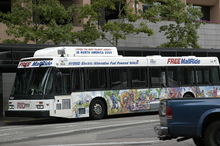Rail transit in metropolitan Denver
 |
|||
 |
|||

RTD's three modes of public transit
|
|||
| Overview | |||
|---|---|---|---|
| Owner | Regional Transportation District | ||
| Locale | Denver Metropolitan Area | ||
| Transit type |
Bus Commuter rail Light rail |
||
| Number of lines | 127 Bus 2 Commuter Rail 7 Light rail |
||
| Number of stations | 53 (Rail) | ||
| Daily ridership | 209,100 (Bus) 86,900 (Rail) |
||
| Headquarters | 1600 Blake Street Denver, CO 80202 |
||
| Website | RTD Denver | ||
| Operation | |||
| Began operation | 1969 (Bus) 1994 (Light rail) 2016 (Commuter rail) |
||
| Reporting marks | RTDZ | ||
| Number of vehicles | 969 (Bus) 172 (Rail) |
||
| Technical | |||
| System length | 76 mi (122 km) (light & commuter rail) | ||
| Track gauge | 4 ft 8 1⁄2 in (1,435 mm) | ||
| Electrification |
Overhead lines, 25k V AC 60 Hz (commuter rail) Overhead lines, 750 V DC (light rail) |
||
|
|||
RTD Bus and Rail (branded as TheRide) is a transit system in the Denver, Colorado, metropolitan area. Operated by the Regional Transportation District (RTD), it currently runs 124 local, 16 express, 16 regional, 16 limited, and 8 skyRide bus routes plus some special services. It also includes 7 light rail lines and an additional 2 commuter rail lines with 71 stations and 87.5 miles (140.8 km) of track.
Bus service in Denver dates back to 1924, when Denver Tramway began the first bus between Englewood and Fort Logan. Buses had completely replaced the previously expansive streetcar system in metro Denver by 1950. However, cars were becoming a larger part of life, and ridership was declining. From 1969 to 1971, Denver Tramway required the sponsorship of the City and County of Denver to continue service. In 1971 with aging equipment, low revenues and lackluster ridership, the Denver Tramway Company transferred all of its assets to city-owned Denver Metro Transit.
In 1969, the Regional Transportation District (RTD) was created in the 47th session of the Colorado General Assembly to provide public transportation to five additional counties in the metropolitan area. It acquired privately owned companies, improved service frequency, and expanded to routes that commercial carriers previously operated such as airport buses.
In July 1974, Denver Metro Transit became part of RTD, and under the new banner, ridership began to increase.
RTD's first light rail line, a 5.3-mile (8.5 km) section of what is now the D Line, opened on Friday, October 7, 1994. It operated with free service for that half day and the first weekend, with revenue service starting on October 10. It was estimated that more than 200,000 passengers rode the new system during its two-and-a-half-day opening weekend, when the fleet comprised only 11 Siemens SD-100 rail cars.
Since that time, several additional light rail lines have been opened. An 8.7-mile (14.0 km) southwest extension to Mineral Avenue in Littleton opened in July 2000, and the 1.8-mile Platte Valley extension to Denver Union Station opened in April 2002. An additional 19-mile (31 km) Southeast Corridor extension along I-25 to Lone Tree and a branch along I-225 to Parker Road were completed in November 2006 as part of Denver's T-REX project.
...
Wikipedia

